YAFR (Yet Another FiiO Review): I’ve been accused of favoring FiiO and even working for them. The fact is they make some of the more popular reasonably priced headphone amps and that’s why I’ve been testing them. Some were surprised I rather liked the $19 FiiO E5 and and $99 FiiO E7. I’ve had lots of requests to review the FiiO E9 and, by popular demand, here it is.
WEDNESDAY ARTICLES: I’m going to try to publish a blog article every Wednesday starting with this one. That should make things a bit easier for those who are constantly checking to see if anything is new here.
SPLIT PERSONALITY: The FiiO E9 is a “desktop” headphone amp and can be used with the usual sources. It also serves as a dock for the FiiO E7 turning the E9 into a USB headphone DAC. The E7 is a portable USB DAC but doesn’t quite have enough output for some large power hungry high impedance cans. The E9 greatly boosts the E7’s output. It also neatly handles the PC USB connection and charges the E7 while its docked.
BUILD QUALITY: The build quality was typical FiiO which is to say most would guess it costs more than it really does. The fit, finish, and details are hard to fault.
UNUSUAL EXTRAS: The E9 sells for a reasonable $129. Check the E9’s Specifications for all the details. There are some unusual features at this price including a protection relay that enables the output a few seconds after power on, and hopefully will disconnect the headphones preventing damage if something goes wrong (DC can damage headphones). There’s also a very useful gain switch on the back that lets you optimize the E9 for low or high efficiency headphones. I explain why this is a good thing in my Headphone Amp article. It’s also nice to have both 3.5 mm and 1/4 inch headphone jacks although I don’t recommend using the mini jack—more on that later.
MINOR NITS: I was a bit disappointed the E9 doesn’t have RCA input jacks for the line input. There’s only a 3.5 mm connector. And none of the connectors on the E9 are gold plated.
IN USE: The big volume knob is nice with an OK feel—it’s a little bit “rubbery”. The power switch is built into the volume control. The small blue power LED is tastefully discrete rather than blinding like some. With high efficiency headphones there’s a little bit of “rustling noise” when changing the volume but it’s masked by music. It runs fairly cool with the metal enclosure getting only slightly warm.
HISS & NOISE: In the low gain mode, and connected to a muted source, there is some slight audible hiss with my efficient Ultimate Ears IEM headphones. The hiss is worst at half volume for reasons I explain in the Tech Section. In the high gain mode, which nobody with efficient headphones should be using, there’s a bit more hiss. But with typical full size cans, it’s dead silent in either gain mode.
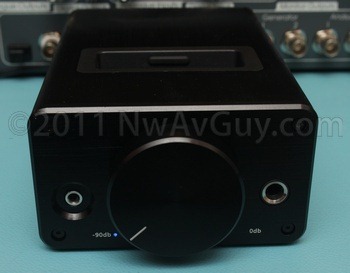 MEASUREMENT SUMMARY: The measurements are summarized below. Power output was excellent and distortion was generally very low into higher impedances. What distortion there is was generally benign and very likely inaudible. The E9 didn’t suffer any of the AMB Mini3’s virtual ground woes. The main problem is an output impedance of 10 ohms on the 1/4” jack and 43 ohms on the 3.5 mm mini jack. Using the small jack will almost certainly affect frequency response and/or bass performance with many headphones—especially balanced armature IEMs (Shure, Etymotic Ultimate Ears, etc.). While using the bigger jack should work reasonably well for full size higher impedance headphones—80 ohms or higher. There was also more noise and channel balance error than I was hoping for. Here’s a comparison with the Mini3, E7 and E5:
MEASUREMENT SUMMARY: The measurements are summarized below. Power output was excellent and distortion was generally very low into higher impedances. What distortion there is was generally benign and very likely inaudible. The E9 didn’t suffer any of the AMB Mini3’s virtual ground woes. The main problem is an output impedance of 10 ohms on the 1/4” jack and 43 ohms on the 3.5 mm mini jack. Using the small jack will almost certainly affect frequency response and/or bass performance with many headphones—especially balanced armature IEMs (Shure, Etymotic Ultimate Ears, etc.). While using the bigger jack should work reasonably well for full size higher impedance headphones—80 ohms or higher. There was also more noise and channel balance error than I was hoping for. Here’s a comparison with the Mini3, E7 and E5:
| Measurement | FiiO E9 | AMB Mini3 | Fiio E7 | FiiO E5 |
| Frequency Response | +/- 0.1 dB Excellent | +/- 0.1 dB Excellent | +/- 0.1 dB Excellent | +/- 0.1 dB Excellent |
| THD 1 Khz 150 Ohms | 0.005% Excellent | 0.002% Excellent | 0.003% Excellent | 0.005% Excellent |
| THD 1 Khz 15 Ohms | 0.037% Good | 0.017% Good | 0.03% Good | 0.012% Good |
| THD 20 hz 15 Ohms | 0.05% Good | 0.01% Very Good | 0.09% Good | 0.6% Poor |
| THD 20 Khz 15 Ohms | 0.003% Excellent | 0.45% Poor | 0.06% Excellent | 0.05% Excellent |
| IMD CCIF | 0.05% Good | 0.043% Fair | 0.03% Good | Not Measured |
| IMD SMPTE | 0.002% Excellent | 0.009% Very Good | 0.008% Excellent | 0.006% Excellent |
| Noise (ref 400 mV) | -88 dB Fair | -94 dB Excellent | -91 dB Good | -86 dB Fair |
| Max Output 15 Ohms | 1067 mW Excellent | 104 mW Excellent | 113 mW Excellent | 108 mW Excellent |
| Max Output 150 Ohms | 317 mW Excellent | 38 mW Fair | 23 mW Fair | 22 mW Fair |
| Output Impedance | 10 Ohms Fair | 0.9 Ohms Very Good | 0.13 Ohms Excellent | 0.7 Ohms Very Good |
| Crosstalk 15 Ohms | 63 dB Very Good | 40 dB Poor | 63 dB Very Good | 46 dB Fair |
| Channel Balance Error | 1.8 dB Fair | 1.14 dB Fair | 0.2 dB Excellent | Sample Problem |
FIRST CLASS:
- Plenty of power to drive most any headphone
- Very low distortion into higher impedances
- Dual gain modes to better match different headphones
- Protection relay
- Nice build quality
- Versatile companion & dock for FiiO E7
ECONOMY:
- Output impedance is high enough to seriously effect IEM headphones
- 3.5mm mini jack output handicapped by 43 ohm output impedance
- Some volume tracking channel balance error
- Mediocre noise levels even in low gain mode
- Mediocre low frequency distortion into low impedance loads
BOTTOM LINE: I had high hopes for the FiiO E9 and while it measured mostly very well I was a bit disappointed. The 10 ohm output impedance is less than ideal while the distortion and noise measurements were not as good as I was expecting. As explained in my article on impedance the 10 ohm output will degrade the sound with some headphones. But if you have high impedance headphones (80 ohms or higher) the E9 is worth considering—especially if you already have a FiiO E7. Besides the convenience of the dock, you can always use the E7 to drive any low impedance headphones you might have (something it does better than the E9). The E9 is otherwise well engineered and the price is attractive for what you get.
DESIGN COMMENTS: The Micca Store claims the E9 uses TI OPA2134 op amps and the TI TPA6120 for the output buffer. The OPA2134 is optimized for audio use and has impressive specs. The TPA6120 is marketed for headphone applications and offers high power, high current, extremely low distortion and wide bandwidth. It’s a stereo IC with both channels on a single surface mount IC with a large heat sink pad on the bottom. It’s used in a number of high-end headphone products. The output is relay switched and hopefully there’s a DC protection circuit for the headphones. The FiiO description says it merely “protects amplifier output” so it’s possible the relay only eliminates turn on/off noises and protects the TPA6120 rather than the headphones. It appears to be AC coupled so I couldn’t simulate a failure by running DC into it.
NO VIRTUAL GROUND: The E9 runs from a single voltage 15 volt DC power supply. It draws about 160 mA with no load and 300+ mA when driving a sine wave at high levels into 15 ohms. Both the input and output grounds measured zero volts DC with respect to the power 15 volt power supply. FiiO says it uses an “internal power converter module” and that appears to be true. As can be seen in the Slew Rate test, it’s capable of about 20 volts peak-to-peak output which would be impossible using a virtual ground and a 15 volt supply. This is a much better design choice than the AMB method of using a third channel or virtual ground. And it’s impressive in such an inexpensive product (bipolar DC-DC converters are relatively expensive).
DC OFFSET: The DC offset measured 1.5 mV in one channel and 3.0 mV in the other—both plenty low.
FREQUENCY RESPONSE: The frequency response was near ideal being 1 dB down at 7 hz and 48 Khz. It was essentially the same with 15, 150 and 600 ohms and you can also see the channels are closely matched to 0.08 dB with the volume control all the way up. Note the entire graph scale is only +/- 3 dB.
POWER OUTPUT: The E9 has enough power to drive most any pair of dynamic headphones. FiiO claims 80 mW into 600 ohms and the E9 measured 84 mW at 1 % THD (clipping) meeting the spec. They also claim 1 watt into 16 ohms, and I measured 1.067 watts. The rise at low levels is mostly noise as it’s a THD+N measurement and the noise remains constant and dominates the measurements at low levels. Note these measurements are using the large 1/4 jack. From the 3.5mm mini jack, maximum output into 15 ohms was only about 250 mW:
OUTPUT IMPEDANCE SMALL JACK: As Maverickronin pointed out in the comments, the output impedance depends on which jack you use. It measures 10 ohms at the large 1/4” jack and 43 ohms at the 3.5mm mini jack. Either is too high for use with most balanced armature IEM headphones. To understand why, see my article on impedance. Here’s the frequency response, from the 3.5mm jack (43 ohm output) of the E9 into my Ultimate Ears IEMs referenced to 1 Khz. Note there is about 12 dB of total variation:
OUTPUT IMPEDANCE LARGE JACK: Here’s the same plot as above but via the large jack with a 10 ohm (vs 43 ohm) output impedance. Note there’s still 6 dB of variation which is plainly audible. I discuss this issue more at the end of the article below. With normal full size cans like the Sennhesier HD600, there would only be a very slight rise (less than 1 dB) around 100 hz:
THD+N 150 OHMS: Here’s the wideband spectrum measurement showing both channels at 400 mV into 150 ohms. The distortion is impressively low and the channels are well matched indicating a reasonably symmetrical PCB layout:
THD+N 15 OHMS: Into 15 ohms the distortion rises considerably. Some rise is to be expected, and the good news is the higher harmonics are all well below –80 dB which is my “rule of thumb” for potential audibility. Only the generally benign 2nd harmonic is above the threshold. This is a respectable result but I expected better from the TPA6120. I have to wonder if there are not some internal power supply issues or poor grounding causing such a rise into 15 ohms:
THD RESIDUAL 150 OHMS: Into an easy load the THD residual is just the 2nd and 3rd harmonics and noise:
THD RESIDUAL 15 OHMS: Into the more challenging 15 ohm load, you can see the strong 2nd harmonic and little else. There’s almost no sign of crossover distortion here which means TI did their homework with the TPA6120:
THD 20 KHZ 15 OHMS: Into a more challenging 15 ohm load at 20 Khz the harmonics are still below –90 dB which is very impressive: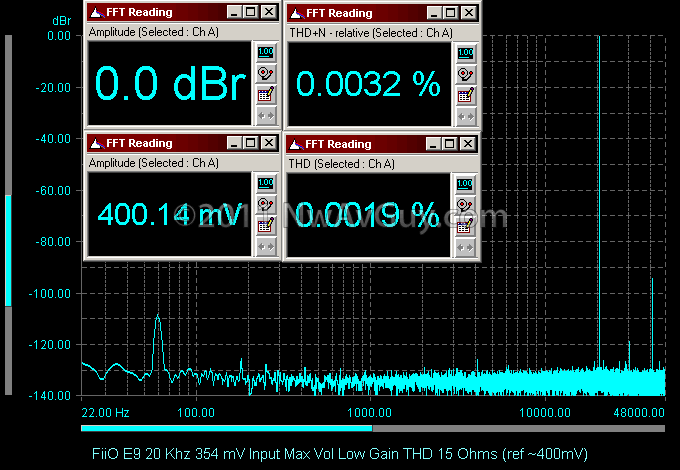
THD 20 hz 150 OHMS: Low frequency distortion with an easy load was around –100 dB which is excellent:
THD 20 hz 15 OHMS: This is an interesting result. At 20 Khz (where there’s generally less feedback available normally resulting in higher distortion) the E9 does much better into 15 ohms than it does as 20 hz. This implies a power supply problem. This test only draws 38 mA of peak current but the current is drawn for a much longer duration and apparently that’s causing problems with the switching DC-DC power supply. The good news is the distortion, as at 1 Khz, is mostly the benign 2nd harmonic. All the other harmonics are below the –80 dB threshold. Plus human hearing is much less sensitive to low frequency distortion. So it’s safe to say this is inaudible but the TPA6120 is capable of much better: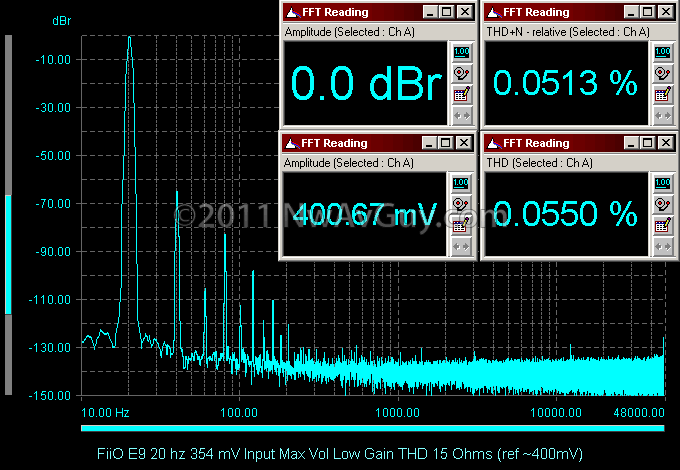
THD vs FREQUENCY: Below is the THD vs frequency at 400 mV with a measurement bandwidth of 22 Khz (hence the drop above 10 Khz). The yellow plot into 150 ohms shows impressively low distortion across the band. The blue trace, however, shows rising distortion as seen earlier in the 20 hz test above. This is likely a power supply problem:
IMD CCIF: This is interesting as the number by itself doesn’t tell the whole story. The 0.055% number is respectable but slightly worse than the AMB Mini3’s 0.044%. But note the odd-order sidebands near the 19 Khz and 20 Khz signals are at –88 dB which is excellent. With the Mini3 these much more audible odd-order distortion products were about 30 dB higher reaching almost –50 dB. The benign 2nd harmonic shows up as the 1 Khz difference signal and dominates with the E9. Even though the percentage is higher, this is much better overall performance than the Mini3 shown in the 2nd graph below. I’m only showing the 15 ohm result here as the 150 ohm result was excellent. 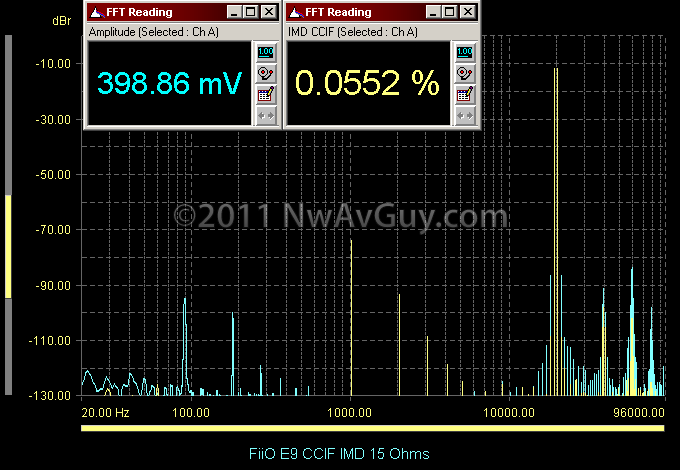
SMTPE IMD: The SMPTE IMD into even 15 ohms was very low and the only obvious issue is the same benign 2nd harmonic seen earlier:
INTERCHANNEL IMD: I ran a new test for the first time on the AMB Mini3 driving each channel to 1 volt but at different frequencies. The Mini3 performed rather poorly creating a dense “forest” of complex distortion products. I decided to repeat the same test on the E9 which uses a proper split power supply instead of a virtual ground. There’s the expected crosstalk at 300 hz while the rest of the spectrum is relatively clean (everything is well below –80 dB) compared to the Mini3:
CHANNEL SEPARATION (CROSSTALK): Into 150 ohms the crosstalk was an excellent 80 dB across most of the range and it degraded to about 63 dB into a 15 ohm load which is still very respectable performance. Both are a huge 20 dB better than the Mini3:
NOISE: The noise performance was a bit disappointing even in the low gain mode. As noted in the first part of the review, the noise is higher at half volume than full volume. This is likely due to Johnson Noise from the volume potentiometer which is worst at half volume (assuming a low impedance source). So first I measured at half volume referenced to my usual 400 mV:
Then I measured at full volume and noted about a 3 dB improvement in the hiss portion of the noise but the hum is about 10 dB worse. It’s interesting that 3 dB was the difference with my SuperFi IEM’s between plainly audible hiss and barely audible hiss. The hum is stray pickup and moving the E9 around didn’t seem to help much. But at –100 dB, it’s safely inaudible.
CHANNEL BALANCE & VOLUME TRACKING: Here the top (white) trace is max volume followed by 3 O’clock, 2 O’clock, 1 O’clock, and 12 O’clock top to bottom. You can see at 12 O’clock there’s about 0.5 dB channel balance error and the total range covered by the top half of the volume control is a bit over 8 dB:
Here’s the lower range of the volume control from 12 O’clock down to 9 O’clock covering another 30+ dB of range:
Here’s the worst case error of 1.8 dB which occurred at the lowest volume setting anyone is likely to use of –45 dB: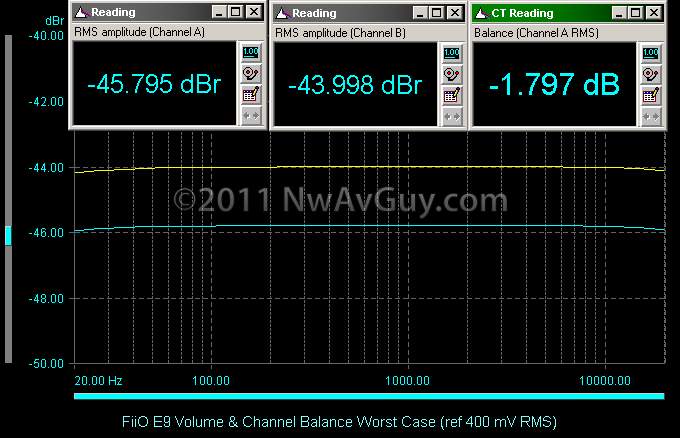
HIGH GAIN: The 10 ohm output impedance makes the gain somewhat load dependent . At max volume in the high gain mode into 150 ohms it’s close to the FiiO specified 18 dB:
LOW GAIN: At the low gain setting into 150 ohms it’s about 10 dB (into 150 ohms the gain switch boosts/cuts the gain by about 7 or 8 dB):
PHASE: The phase performance, as expected from the frequency response, isn’t perfect but 7 degrees error at 10 Khz is respectable. It’s really 180 degrees out of phase as the E9 inverts absolute polarity:
INPUT CLIPPING: The FiiO E7 suffered from “premature” input clipping at 1.25 V RMS due to its battery powered design. The E9 has a more typical clipping voltage of about 2.1 volts as seen below. Here the volume is turned down for the standard 400 mV of output and the input voltage is shown on the right. This allows typical 2 volt consumer line level sources to be used with the E9 without any problems:
SQUARE WAVE PERFORMANCE: The slightly rolled off high frequencies caused the expected rounding of a 10 Khz square wave but the good news is even driving a reactive load (Sennheiser CX300 headphones in this case) there’s no sign of any ringing, overshoot, or other instability. The 10 ohm resistor in series with the output isolates the reactive load and this is a very stable result. Note it’s inverting absolute polarity as mentioned above under Phase:
SLEW RATE: The ultimate slew rate was plenty fast at about 7 volts per microsecond. The E9 only needs about 1.4 V/uS to not be slew limited. FiiO probably chose to limit the slew rate (the TPA6120 is spec’d at 1300 V/uS!) and, for stability reasons, I would do the same. You can also see the E9 is producing almost 20 volts peak-to-peak as further proof it’s not using a rail splitter, third channel or virtual ground (which would only allow about 14 volts peak-to-peak from the 15 volt supply):
OUTPUT IMPEDANCE COMMENTS: The extremely wide bandwidth of the TPA6120 makes it inherently less stable. Unfortunately, TI made it much faster than it needs to be for audio use and it also is not a pure buffer—it has gain. For these reasons, it’s easy to understand why TI recommends a 10 ohm series output resistor to isolate reactive loads. The National LME49600 and TI/Burr-Brown BUF634 are competing parts that do not require an output resistor for stability. The TPA6120, however, is significantly cheaper on a per-channel basis so I can understand why FiiO chose it for a $129 amp. But the 10 ohm output resistor is a bit of a “band-aid”.
TECH SECTION SUMMARY: In many ways the E9 measured very well. The distortion is impressively low—especially into higher impedance loads. But I do have some concerns:
- The biggest disappointment was the 10 ohm output impedance. As I’ve shown above, even 10 ohms causes 6 dB of frequency response variation with balanced armature IEM headphones. Using the 3.5mm jack is even worse with its 43 ohm output impedance. 10 ohms should not cause any serious problems with normal dynamic headphones rated 80 ohms and higher. See my article on impedance.
- I’m guessing FiiO added the extra 33 ohms to the mini jack to help avoid accidental headphone damage with low impedance headphones. But it seriously compromises the performance of the amp. And, ironically, nearly all balanced armature IEMs have a 3.5mm plug but you very much want to use the E9’s big jack with these headphones (or even better, the FiiO E5, E7 or another amp with near zero output impedance). A better solution would have been for FiiO to further lower the E9’s gain for the low setting to limit the output to a reasonable level for low impedance headphones.
- If you have an E7 you can always use it to drive low impedance headphones and use the E9 only for high impedance cans.
- The noise performance, even in the low gain mode, was disappointing—especially at half volume. The measurements were consistent with what I heard with my sensitive IEMs.
- There was some channel balance error around 0.5 - 1 dB at several settings and a max of around 3 dB at –50 dB. This isn’t awful, but it’s marginal if you plan to use really sensitive headphones and listen at very low volumes.
- The low frequency distortion into 15 ohms was much higher than the the TPA6120 is capable of. It’s not alarmingly high, but it’s a sign a corner or two was cut or someone got sloppy with the design. This is a classic case of getting nowhere near the datasheet performance from the OPA2134 and TPA6120 due to implementation issues.

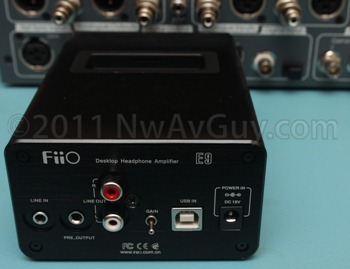
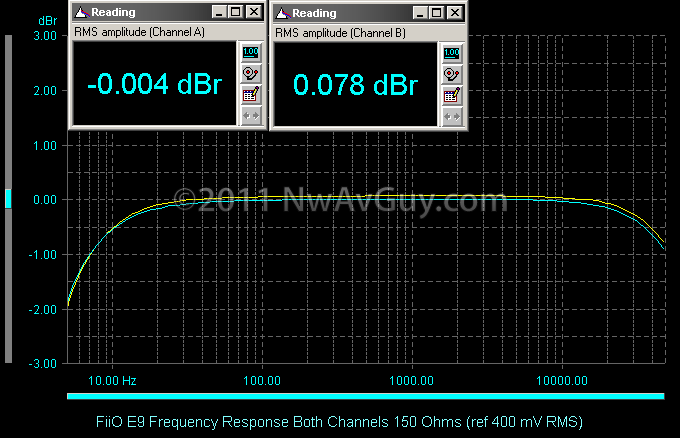
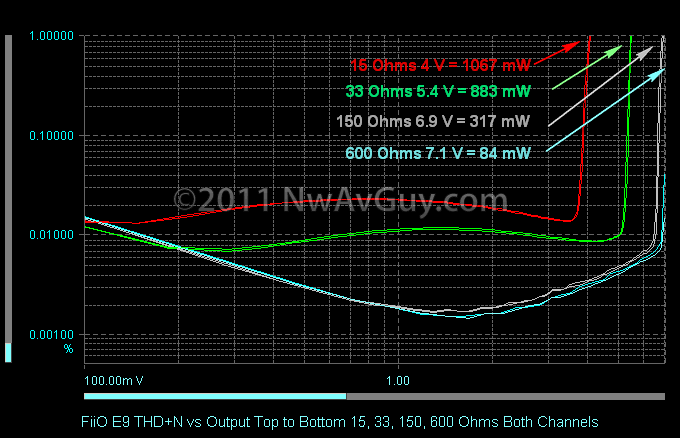
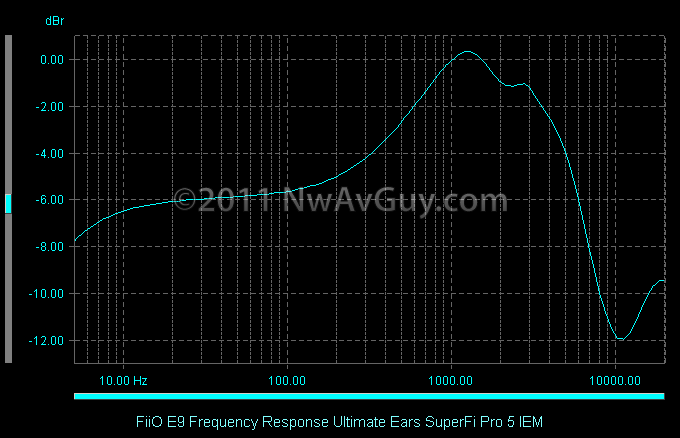
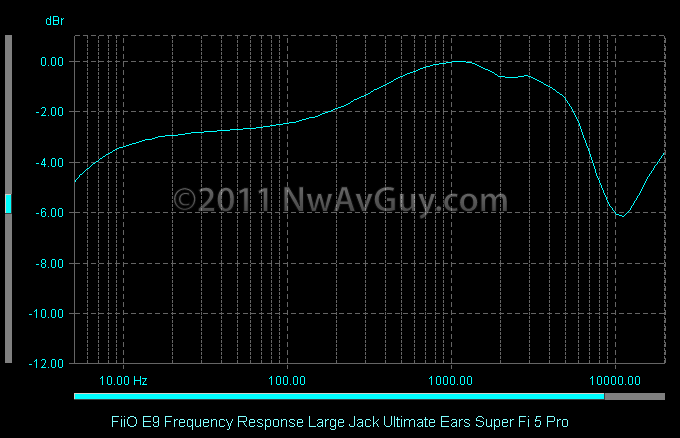
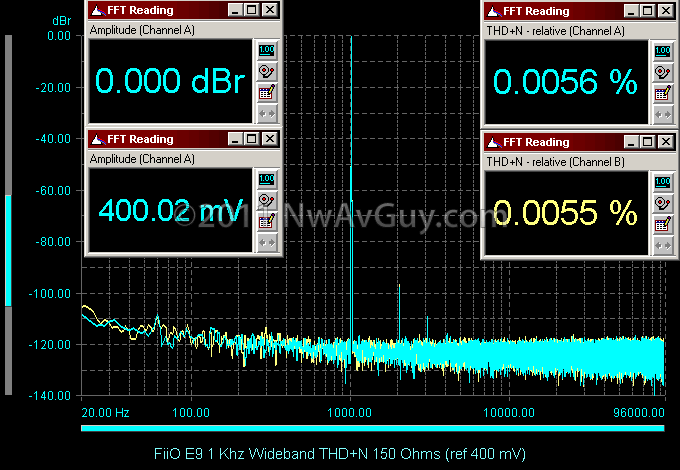


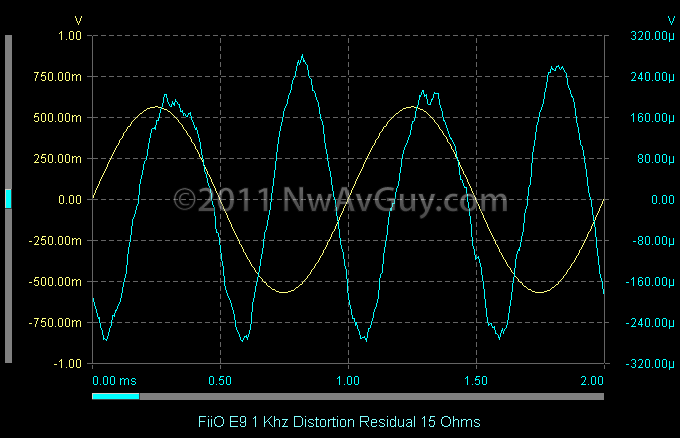

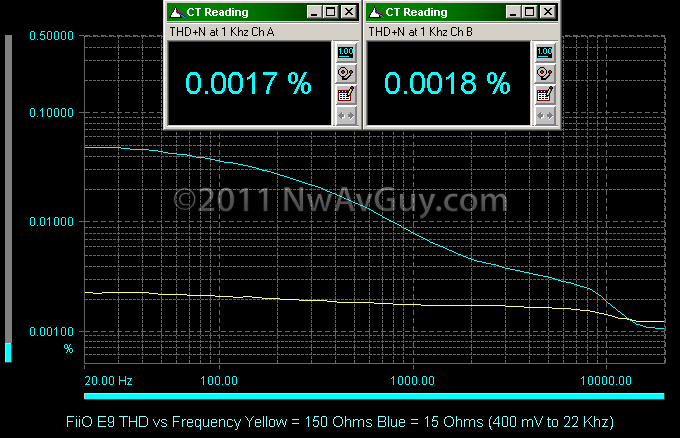
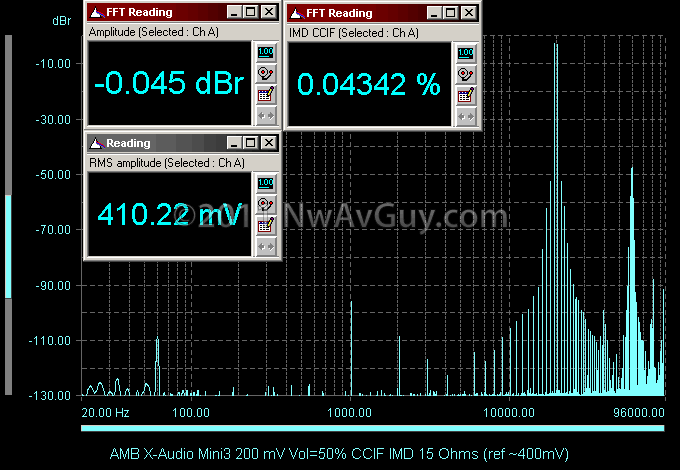

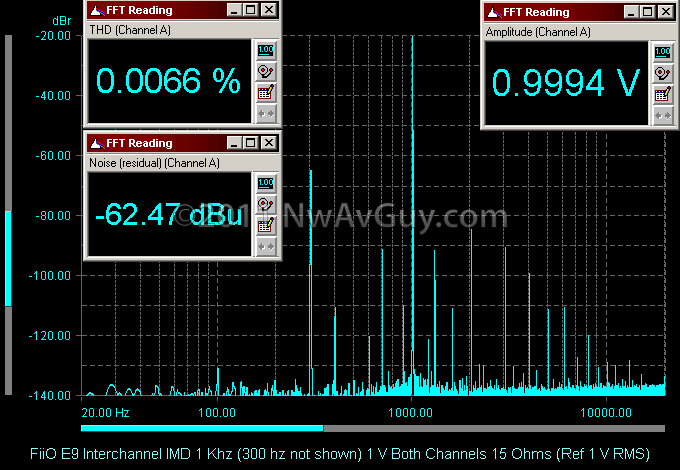
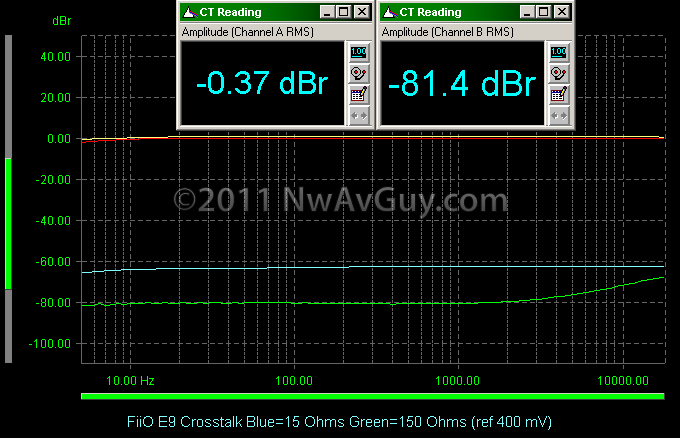
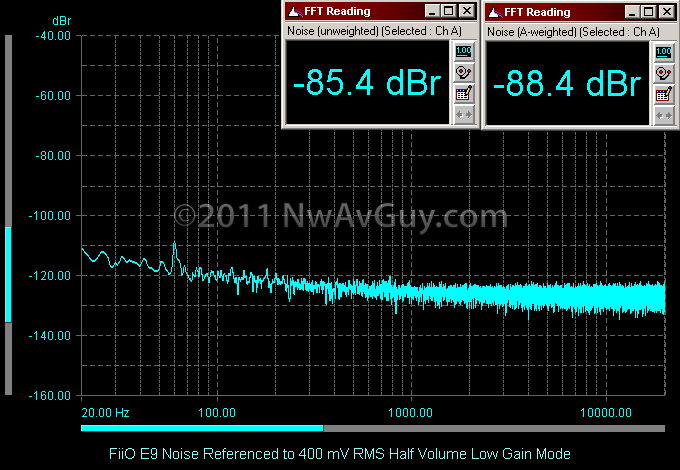
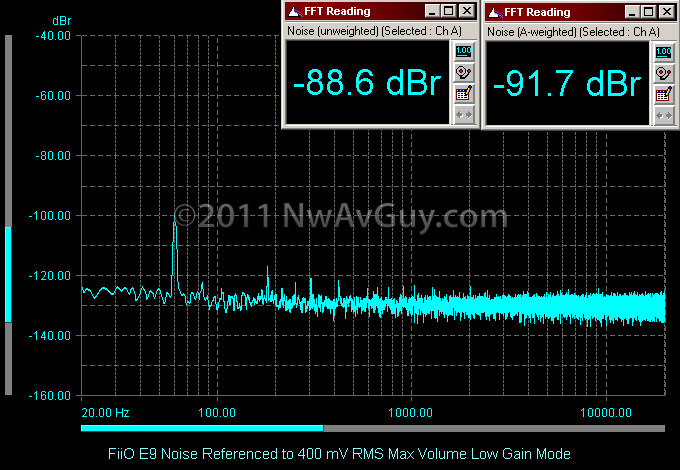


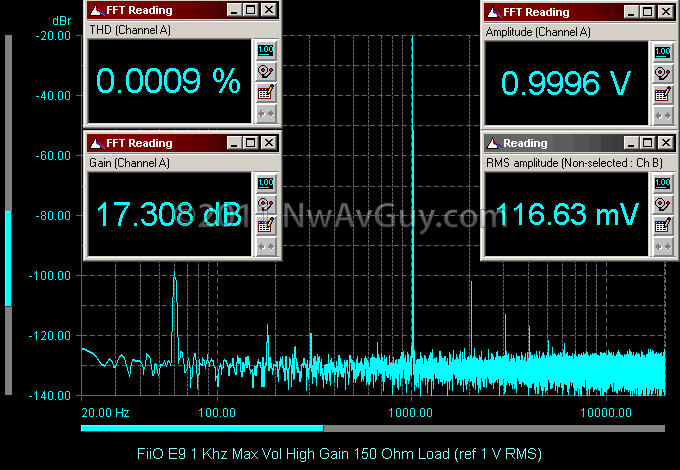
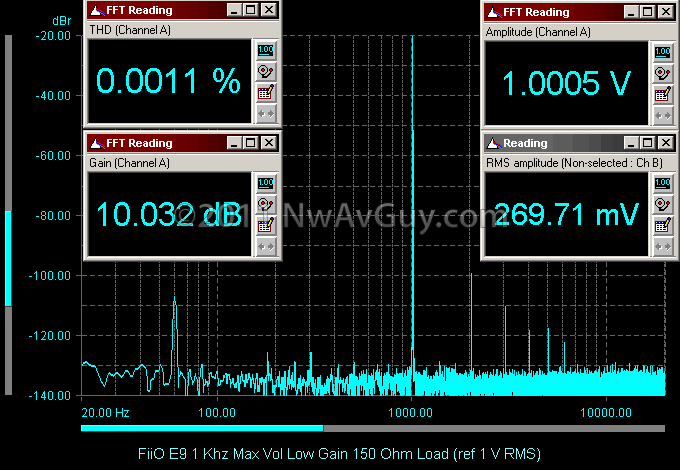


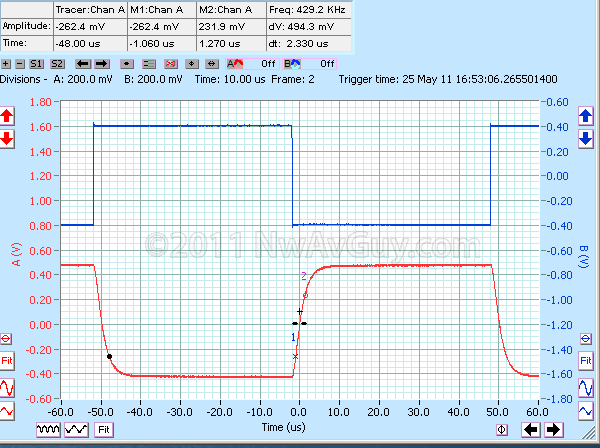

Wow, the output impedance is really disappointing. I can accept it in the ~$30 UCA202 (which I now own thanks to your review), but not in a product like the E9.
ReplyDeleteAnyway, thanks for the review, great read as always.
Did both the 1/8" and 1/4" jack measure the same?
ReplyDeleteI remember reading somewhere that the 1/8" jack had an extra inline resistor to make it quieter with sensitive 'phones.
Thanks Maverickronin. Doh! I didn't even think to check both jacks and you are correct. A quick check shows the output impedance is 10 ohms on the 1/4" jack which means I have some revisions to make.
ReplyDeleteFiiO added an extra 33 ohms to the 3.5 mm jack. The unfortunate thing is most (all?) IEMs have 3.5mm plugs--and they will suffer most from the extra 33 ohms.
Thanks a lot for your as always outstanding and in depth review. ^_^
ReplyDeleteRegarding the protection relay, after reading about that I did a google search and stumbled over this: "
I recently purchased a Fiio E9 and use this with my MP3 player (sansa clip and also an old IRiver H10). I notice when I switch the power on the E9 it vibrates gently and you can "feel" the electrical current pulsing through the unit...." (oldest post)
"...the voltage travels along whatever lead I have plugged in to it to my amp, laptop, CD player etc. and is then present on their metal casings too...." (latest post)
http://www.anythingbutipod.com/forum/showthread.php?t=59895
What do you think of that?
Been aching for a new article for a long time, thanks for yet another great read!
ReplyDeleteIt seems that the decision to increase outputZ on the 3.5mm jack was to _improve_ performance with IEMs. Are manufacturers really that unaware of the negative effects a high outputZ has on BA based (a fairly large part of the mid-to-high tier) IEMs?
Anon, I just responded to the ABI post. My E9's AC adapter didn't have excessive leakage but it sounds like some do. This isn't a fault of the E9 itself, but the AC adapter supplied with it.
ReplyDeleteb0ck3n, the output impedance issue is a mess as there's no clear standard. If FiiO thinks a higher output impedance is better for portable headphones why do the E5 and E7 have a near zero output impedance?
ReplyDeleteWhat impedance the headphone manufactures design for is what's most important. And, I think it's safe to say the majority of IEM manufactures design for a low output impedance--either zero or around 2 - 7 ohms (a typical iPod). Using their IEM's with a higher impedance, like the E9's 43 ohms, will change the sound from what they intended (see the graphs in this review).
I believe FiiO added the 33 ohms to the 3.5mm jack in a crude attempt at avoiding headphone damage from someone getting careless with the volume control. 1000 mW into 16 ohms could easily damage many headphones but the extra 33 ohms reduces that to about 250 mW.
The gain switch on the back of the E9 is a better solution. FiiO could just further lower the gain in the low gain mode and that would limit the maximum output to a reasonable level for 16 ohm headphones without compromising the output impedance.
So now I guess the question is can the 10 ohm resistor be removed and will it break anything if you do.
ReplyDeleteMy T50RPs still hunger for more power with the occasional high dynamic range or quietly mastered track.
Maverickronin, I'm going to be experimenting with the TPA6120, and alternatives to the 10 ohm resistor, but the short answer is you can't just bypass it. The extremely wide bandwidth of the TPA6120 makes it inherently less stable. Unfortunately, TI made it much faster than it needs to be for audio use and slapped the resistor on as a bit of a band-aid. The National LME49600 and TI/Burr-Brown BUF634 are competing parts that do not require an output resistor for stability. The TPA6120, however, is significantly cheaper on a per-channel basis so I can understand why FiiO chose it for a $129 amp.
ReplyDeleteAs always, thanks for reviewing stuff I have heard of and actually might buy (or already have). Your replies to comments are easily just as interesting and informative to read as the article itself.
ReplyDeleteWouldn't a 1/8" jack to 1/4" plug adapter work for listening with IEMs? Of course picking E9 instead of/in addition to E7 for IEMs is kinda silly anyways.
ReplyDeleteThank mikeK and to Traf, yes, that certainly is possible. Lots of people into headphones have a selection so it's useful for an amp to be a good "all rounder" that can properly drive a variety of phones. For example, I know someone who uses a pair of open backed full size Sennheisers when he's not worried about disturbing others and Shure IEMs when he is. It's hard to beat the isolation of IEMs and its hard to beat the sound quality of some of the balanced armature variety. But you might also listen to full size cans sometimes too.
ReplyDeleteHey,
ReplyDeleteThis is Jack from Miccastore.com. Excellent and thorough review as usual.
NwAvGuy, I don't know if you've seen this block diagram of the E9 yet, but it contains some good information that may give you more insight into the E9's design:
http://cdn.head-fi.org/d/d2/d2b84a94_E9diagram.jpg
And if you have not yet opened up the E9, here are some photos of its internals:
http://forum.miccastore.com/index.php/topic,175.0.html
Some of the components in question are plainly visible. I have one of the early E9 prototype units where the gain switch's effect is not nearly as pronounced as the production version. I am going to take a closer look at the PCB layout near the gain switch tonight.
In any case, thanks for the informative review. I am sure you are going to be inundated with requests for other FiiO product measurements now.
Jack
Jack, thanks for that schematic. Now I'm interested to explore what LM22670 can do.
ReplyDeleteNwAvGuy, correct me if I'm wrong (seriously), but I thought that adding a resistor to the output is a common hack for raising the impedance of headphones that would otherwise be too low. I.e. a last ditch attempt to avoid unwanted changes in frequency response due to impedance mismatch. And also to give more leeway on the volume control. I've seen this with the Yulong D100 and the Audiotrak Dr.DAC2, at least.
Sorry if this was already covered this elsewhere. But does anyone happen to know what type of power supply scheme the E5/E7 uses?
Eagerly awaiting the E11 review.
Great info, as usual! I'm also a bit disappointed by the E9's high output impedance. The usual workaround that I use for pro audio gear and IEMs is similar to the way a loudspeaker amp can be used to power headphones, and that's with a voltage divider, say 33 ohms + 0.47 ohm. The headphone amp sees an almost constant impedance a little over 33 ohms, but the IEM sees a fraction of an ohm. The ones with crazy impedance curves usually have high sensitivity: 20 to 30mV is usually enough for ~90 dB SPL. So power resistors aren't even needed. In some cases, this arrangement has resulted in less noise. For the E9's 3.5mm jack, 15 ohms + 1 ohm works well for me. It sounds pretty good too, and it certainly flattens the frequency response of those trouble IEMs. Some headphones even sound more powerful, even though we're throwing away most of the energy.
ReplyDeleteIt would have been nice if FiiO had included such a low-impedance "adapter". Very often, it's a lot more useful than the ones that just stick a 75 ohm resistor in series with the IEM. What kind comes with your SF5Pro, and does it alter the sound? I'm embarrassed to admit that one time, I jerry-rigged a kludgy voltage divider hack from two Y cable splitters and two passive inline volume controls (passive attenuators made by Shure and Sennheiser). You can dial in ~1 ohm for the lower leg of the divider and still have control of the other value. The Sennheiser has separate left and right sliders so you can take care of any level difference between channels. It wasn't pretty, but it worked.
Of course, an E5 is small enough to take with you to a gig in case you need a headphone output with low output impedance. But I don't think folks will want to hook up the E5 to the E9's line out or pre out, even if they can put up with constantly having to disconnect headphones from the E9. Even the companion E7 needs to be removed from the dock if you want to listen to it. At this rate, the band aid on top of the band aid might be more convenient.
BTW, the ASUS Xonar Essence One supposedly uses an LME49600. It could be interesting.
Yoga Flame, the power supply is roughly the same in the E5 and E7. Both use the Li-Ion battery directly for the positive power supply and the output chip amp has a built in charge pump that creates a true negative supply. I discuss it in the tech section of the E7 review.
ReplyDeleteYuriv, what you suggest might help but you can only use a divider ratio of 1/8 before you drop below unity gain even in the high gain mode. So to get down to 1 ohm, the resistors would be 7 ohms and 1 ohm presenting an 8 ohm load to the amp which is too low. 2 ohms and 15 ohms would work OK, but even then the distortion is going to be much higher than it ideally should be due to driving a large signal into a low impedance. 2 ohms and 33 ohms, or 1 ohm and 15 ohms, might not give you enough signal with some sources and/or headphones.
You also need to be careful not to overheat the TPA6120 as it has very little heatsinking in this design. While the E9 is rated at 1 watt into 16 ohms, it can't sustain that power, or even half that power, with both channels being on the same chip.
Thanks, NwAvGuy. That was an informative read. I take it that the LM22670 chip is the inverting charge pump for the E9, and the "pi" filter reduces (removes?) the switching noise created by the chip. I'm now inspired to attempt a single to bipolar power supply converter as my next semi-noobish DIY project.
ReplyDeleteBack to the E5/E7, that TPA6130 chip sure packs an impressive array of features. I'm still a little unclear on how the opamps get their negative rail though, since those come before the TPA output chip.
Re: Voltage divider.
ReplyDeleteWhat I had in mind wasn't a universal adapter for all headphones. Full size cans don't really need one on the E9. The divider was specifically for BA IEMs, so we don't need it to go to unity gain at maximum volume. Those need attenuation, and lots of it. It's fascinating that some of them need very little voltage to do their job. For these, we can have 1 ohm for the lower leg of the divider, if not less. We have some wiggle room for the choice of the other resistor. Should we use more resistance, and hence more voltage from the E9, or less resistance and voltage? I'm looking at your THD+N and other graphs to see if we can find a sweet spot where the E9 will be happy. I'll have to try this later with my least sensitive BA IEM to see what value resistors I can get away with.
On full size headphones, 10 ohms in series shouldn't make the mid-bass go up by more than 1.5 dB over the lowest point, even with the HD598 and HD595. Those two should produce a bigger swing than most normal headphones, if I've done my arithmetic right. Noise and channel balance issues aside, I think the E9 sounds just fine on my HD600/650, ATH-M50, 7506, etc. It should be ok on almost anything except a Monster Beats Solo or something similar.
Yoga Flame, The Opamps in the E7 run from a single supply as near as I can tell. That's why the input clips at such a low voltage (see the review). In the E9 it has a true dual supply for everything.
ReplyDeleteYuriv, you're correct with your comments. But it does matter what your source is. Players with EU volume limiting, for example, can often only manage around ~220 mV of clean output. So you can't attenuate too much with your divider if you want to use that sort of source and still have plenty of headroom for music with a wide dynamic range.
If a headphone (not BA) has a flat freq vs. impedance curve, will the 10 ohm output impedance of the E9 matter?
ReplyDeleteAlso, thanks for an awesome blog.
Eujaee, I'm not sure such a dynamic headphone exists. Every headphone I know of has a resonance within the audio range and/or a rising impedance with frequency due to the inductance of the driver. But some over 80 ohms are flat enough for the 10 ohms output impedance not to change the frequency response enough to probably matter.
ReplyDeleteEven if the impedance was flat, the 10 ohm output impedance will still reduce the electrical damping. Again, for headphones over 80 ohms the reduced damping may not be audible.
Some headphones do have a very flat impedance curve. Check out the Denon AH-D's for example. Even a hundred ohms output impedance wouldn't cause big changes in the frequency response.
ReplyDeleteAnd don't forget that some manufacturers design for an output impedance of ~120 ohms. Beyerdynamics A1 amp is designed with a 100 ohms Zout for example.
Anyway, there's also the option to use an EQ to not only "fix" the changes in FR, but also to improve the overall balance and small flaws in the FR of your headphones.
Btw, the comment feature is quite bugged with the latest IE, Chrome and Firefox. Possibly other browsers too. Actually, it doesn't work at all when posting as anonymous.
I can't do anything about the comments being buggy besides complaining to Google. You would think it would at least work right with their own browser--Chrome!
ReplyDeleteWhat seems to help is using Preview first and then submitting the comment. Sometimes it takes multiple attempts. But once Preview works, the comment will usually submit OK.
As for headphone impedance, I have the Denon AH-D2000s and they're not completely flat but they're much closer than most. They have a resonance peak way down at 30 hz and a slight rise starting at 10 Khz.
The total variation is about 16% or 4 ohms. The bad news is they're low impedance (25 ohm) so using a 10 ohm output like the E9 has, you still get about 0.5 dB of variation in the frequency response.
But, more important, the change in damping factor is significant with the Denon's. A 0.1 ohm output like the E7 gives a damping factor of 250. The E9 gives a damping factor of only 2.5 or 100 times less.
You generally want a damping factor of at least 20 and many would say even higher. Adding 10 ohms to the 25 ohm Denons is likely to audibly change their bass performance with a damping factor of only 2.5. But adding 10 ohms to a 250 ohm headphone isn't a big deal.
As for the 120 ohm output impedance, I talk about that in my Impedance article (Feb). That standard predates the "iPod Age". It's entirely impractical for a small battery powered device to have a 120 ohm output impedance (it would be very wasteful of battery power when driving typical portable headphones).
ReplyDeleteIn talking with Sennhesier, for example, they mostly design for an output impedance of about 7 ohms or less. And they say many of their headphones work best with a 0 ohm output. Grado has made similar comments.
The impedance thing is really a mess as few manufactures disclose what impedance they designed a particular model for. So we end up with lots of compromises and confusion.
It's funny you mention the Beyer amp, because my Beyer DT770 Pro 80s sound notably worse with 120 ohms--the bass gets boomy and unpleasant. I talk about that in the 770 review. Using the Denon AH-D2000, another full size fairly high-end headphone, on a 120 ohm output also yields terrible results as it removes nearly all the amp's bass damping.
While I agree that it's impractical for small portable devices, many if not most stereo receivers have an output impedance of 100+ ohms. The A1 is just one example for a desktop headphone amp with high output impedance that came into my mind. Also, it doesn't matter if the standard is 1, 10 or 100 years old. What matters is how manufacturers implement it into their products.
ReplyDeleteIt's funny you mention the DT770-80 because, as beyerdynamic explains on their website, this version is made for something like mp3 players and not beefy hi-fi desktop amplifiers. Also, the DT770 is known to have a bit over-the-top bass and some people find the bass response unpleasent regardless of Zout.
I don't understand your D2000 comment... The measured impedance is very flat and the resonant frequency very, very low (around 30 Hz) so no big changes there. "Damping" and "damping factor" are usually used as audiophile FUD and for marketing. If you had taken a look at the step response of the D2000 powered by a 0 ohm Zout device you'd have noticed that there's a lot of overshoot and ringing. This actually improves if you increase the Zout. Overshoot will be reduced and the oscillation/ringing as well.
Damping factor is audiophile "FUD" when you're comparing a 0.04 ohm output impedance to a 0.02 ohm output impedance (i.e. damping factors of 200 and 400 respectively). But when the output impedance starts to approach, or worse, exceed that of the driver, it's a very real issue.
ReplyDeleteDepending on how a driver is made, a substantial portion of the damping can come from the amplifier versus the mechanical suspension of the driver. If you don't believe this is true, just try tapping on a woofer cone of a speaker with it disconnected from the amplifier, and with it connected and the amp turned on but not playing anything. You should notice a distinct difference due to the electrical damping. This isn't "FUD" it's 100% real. Now try the same test with say a 40 ohm resistor in series with the speaker, you'll find the result is different still. That 40 ohm resistor is like a 120 ohm resistor to the 25 ohm Denon headphones.
In both of my examples (D2000 and DT770-80), I was talking about the output impedance (120 ohms) exceeding the driver impedance. This noticeably changes the damping of the driver, and hence the sound. It easily survives a blind listening test.
Headroom had this to say about the AH-D2000: "it's overall sensitivity and driver mass will still benefit from dedicated headphone amplification and control to hear what the D2000 can sonically accomplish". And I have to agree with that. The bass is much less pleasant from a 120 ohm source.
It's possible to make drivers much more linear if you can use a lot of electrical damping. This is why acoustic suspension speakers didn't really become popular until solid state amps with low output impedances were widespread. The much longer, and more linear, excursion of a driver designed for a sealed enclosure doesn't work well from the relatively high output impedance of most tube amps.
To sufficiently damp drivers without using electrical damping, the driver is typically less linear, has less excursion, compresses the signal more at high levels, and has higher overall distortion. This applies to headphone drivers as well as loudspeaker drivers. I explain this in my Impedance article.
The diaphragm of a headphones' driver hardly moves (at normal SPLs) and there's no suspension like in speakers. Instead, the material between the diaphragm and frame keeps it in place.
ReplyDeleteAdditionally, the impedance of the D2000s for example is for the most part of resistive nature, i.e. acts like a resistor. All of this makes damping less of an issue for the D2000 and similar headphones.
"It easily survives a blind listening test." Well, that's a moot statement unless you can provide a link to one where the D2000 or similar headphone was tested.
Headroom says a lot of funny things and of course they are going to encourage their high-end headphone customers to spend some money on one of their amps.
Above I mentioned overshoot and ringing. There's both over- and underdamping, both of which are non ideal. By the reduction of overshoot and ringing as explained above the drivers' performance actually increase with increasing Zout, but only up to some point of course.
I've heard and owned a couple of headphones where the bass is actually much _more_ pleasent from a 120 ohm source. Especially the ones' the manufacturer supposedly designed for use with such sources.
"The much longer, and more linear, excursion of a driver designed for a sealed enclosure doesn't work well from the relatively high output impedance of most tube amps."
Headphone drivers, unless overdriven, have tiny excursion and often are mounted in non-sealed constructions. The outer enclosure may be closed, but internally there can be an opening between the front and back of the driver. Therefore, I don't think that concepts from speakers can be applied directly to headphones without more thought on these important details.
As I discuss in the Impedance Article there are some people who might prefer the sound of a particular headphone from a higher impedance source. That's entirely subjective. Some people, for example, like boomy uncontrolled bass.
ReplyDeleteDynamic headphone drivers follow the same laws of physics and hence the same Thiele-Small parameters as loudspeaker drivers including electrical and mechanical damping. Thiele-Small parameters are largely independent of the signal level, and hence excursion, until you start to reach the limits of the driver. Please see the link I provided.
You might also want to read pages 3 and 4 of this Stereophile Article discussing the output impedance issue. In reference to the 120 ohm standard they said:
"Whoever wrote that must live in a fantasy world"
They go on to document just what 120 ohms does to the performance of a pair of full size AKG headphones. And I have provided similar examples in my articles.
I have talked to a Sennheiser employee who explained they design their headphones for low output impedance sources so they can take advantage of electrical damping from the amplifier. This allows them to design better headphones--just like speaker designers can design better speakers for solid state amps. It's very analogous.
Headphone drivers have suspension--otherwise the diaphragm couldn't move and wouldn't work correctly. They also have moving mass and we know an object in motion tends to stay in motion. So damping is required or it will "ring"--keep moving after it should have stopped. The amplifier can electrically damp the driver and/or the suspension can mechanically damp it. Mechanical damping requires resisting the motion of the driver to provide damping, much like a shock absorber resists the motion of a car suspension when you hit a bump. But, in both cases, that has unwanted side effects. It makes the car ride more harsh, and it makes the headphone driver less linear which produces more distortion.
You are correct that you ideally want optimal damping. And the best way to assure that always happens in this iPod world, is for amps to have near zero ohm output impedances and all headphone designers can design to that goal. Otherwise it's just an incompatible mess.
if you want to discuss this further, I'd suggest leaving comments at the end of the Impedance Article instead as this is getting a bit off topic for the E9.
This sounds like it could be a good topic for a future article, one that builds on a technical analysis done by Dick Pierce several years ago. In his argument, he seemed skeptical about the audibility of reduced electrical damping until the amplifier's source resistance gets very high. And that's at system resonance, where the motion of the cone is most uncontrolled. He argues that the frequency response variations resulting from high Rs are far more audible, and for that, he proposes that a damping factor of 5 is good enough.
ReplyDeleteIf we had Qmc and Qec for typical headphones, we could compute Gh(max). But DP doesn't show us how he got the numbers for the decay time, or for that matter, how he defines it. More convincing would be actual measurements. How does a headphone's response in the time domain change with varying amplifier source impedance? Someone with a head simulator is in a good position to answer this question. Maybe it will be an article on Tyll's site some day.
But maybe we can answer the same question, albeit more indirectly. If a headphone's diaphragm is still moving, then there should still be an induced emf that's proportional to the rate of change of the magnetic flux through the coil. We can measure that. Headphones, after all, are microphones in reverse. The graphs from these measurements could show (indirectly) how long it takes the diaphragm to stop moving, and what path it takes to get there.
From what I remember a while ago, I didn't have much luck with impulses. A wider pulse might have produced more initial displacement. I had better luck with 5Hz square waves (played at a safe level). Or I played a tone burst at the resonance frequency, and then looked at the headphone's response right after the burst. That's to see how long the headphones continue to play after the worst-case signal abruptly stops. You can vary the amp's source impedance with a passive inline volume control if you want a quick and dirty result. If memory serves me right, the headphones with flat impedance-vs-frequency did better, but the theory could have predicted that.
Back to the E9: The 10-ohm output impedance should be low enough with most headphones when it comes to damping. I'm with DP here; I don't hear any sloppy bass, even on lower-impedance cans with high peak Z at resonance. What I'm hearing is a slight difference in the frequency response. The time-domain response is, of course, related to the FR, so call it what you will.
My rule of thumb is a damping factor of at least 8 rather than 5 but I mostly agree. A damping factor >20 provides a good margin of safety.
ReplyDeleteUsing 25 ohm headphones, like the Denon D2000s, on a 10 ohm output is a damping factor of only 2.5. That's likely to cause audible problems. And with a 120 ohm output, as proposed by anonymous, it's a damping factor of only 0.2 which is clearly going to change the sound.
I've made several revisions to my Impedance Article and I probably should make some more. Lots of people have linked to that article so it's likely the best place to further at least part of this discussion.
I agree with you it would be interesting to make more measurements. And I have some plans under way to do so.
Follow your blog for sometimes, and it is very informative. Thank you for your effort of telling these technical stuff, so we can know the fact of the product we are going to buy.
ReplyDeleteI have copied the comment of ClieOS in Head-fi which seem to concern the purpose of using E9 with hard-to-drive headphone, and I agree with his statement.
"E9, for all its intention, is really designed for hard-to-drive headphone in mind. I have another DAC / AMP with the same TPA6120 chip, and it has about the same output impedance issue driving low impedance headphone and IEM. Hence why E9 and E7 are meant to pair together. One handles high impedance headphone while the other handles the low impedance stuff."
http://www.head-fi.org/forum/thread/559604/fiio-e9-detailed-review-and-measurements#post_7559171
NwAVGuy, I cannot express how much I appreciate this blog. In an industry where every damn Head-fi review is "OMG GIANT KILLER" and Headfonia ADORES the Schiit Asgard (and then tells you they get commission for each Asgard sold on Amazon!), your technical and common-sense approach is a huge breath of fresh air. This blog has likely saved me thousands of dollars I would have spent in the future.
ReplyDeleteHere is my question: How close do you think the Fiio E9/Fiio E7 combo comes to reaching the desired "point of diminishing returns"? I know it's a very subjective thing... so I guess I'm asking for your opinion about it.
Right now, I'm running a foobar--> uDAC1 ---> Sennheiser HD600 setup, so I was wondering if the Fiio E7/E9 option represents a good upgrade for me.
Since I plan on getting more headphones in the future, if the Fiio E7/E9 is close to the diminishing returns point, it allows so much flexibility, with the ability to drive headphones up to 600 ohms (important, because I have a feeling I'm gonna go for a Beyer DT880/600 in the future).
Anyways, thanks again for the great blog! We need more people like you in this hobby, don't stop what you're doing!
Joakcbasse, thanks for the all kind words. The original uDAC supposedly had even more problems (especially channel balance problems) than the uDAC-2 I tested. So an upgrade might be worth considering.
ReplyDeleteThe E9 works well with the HD600. The 600/650 impedance is high enough the 10 ohm output impedance of the E9 isn't a big deal. And, as you probably read here, the DAC in the E7 works quite well. The noise of the E9 also isn't an issue with the HD600 (but is with sensitive headphones).
So you could do a lot worse than the E7/E9 pair. But they're still around $230 combined and you can probably do better if you wait...
I'm not sure if you have looked at my O2 Headphone Amp articles, but the whole idea behind the O2 was to drive anything from the DT880-600 which needs lots of voltage, to the HiFiMan planars that needs tons of current, to the most sensitive balanced armature IEMs that need a very low output impedance and ultra low noise. The O2 does all that and handily outperforms both the E7 and the E9. So it might be worth waiting to see how the commercial possibilities sort out for the O2 in the next few months.
I'm also going to be testing some other relatively inexpensive USB DACs including the little Asus Xonar U3. My hope is to find something small, cheap, and portable (like the uDac but better engineered) that performs well enough to pair with the O2 for no-compromise sound. The Creative X-Fi HD is also on the agenda.
I've seen your O2 Headphone Amp articles, but I haven't gotten around to reading it.... the other articles in this blog have taken some time for me to fully digest. But from what I have skimmed, the O2 Headphone Amp sounds like a great idea. I'll definitely keep an eye out on its status.
ReplyDeleteHeck, since the O2 is some time away, I may just get the Fiio E7/E9 now AND the O2 when it comes out in a couple of months.
Another question: From what I gather from reading your posts, you don't necessarily believe in "synergy" between headphones and amps... other than properly matching headphone and output impedances, correct? So, if a headphone and source are properly matched, the amp is strong enough to fully drive the headphones, then there's really no difference between a cheaper and expensive amp (given that neither are colored... which is an undesirable trait and should be avoided anyway)?
It's not quite so black and white but you have the right idea. Most of the so called "synergy" is either imagined because of subjective sighted listening bias, or a result less-than-ideal higher output impedances.
ReplyDeleteBut, that said, if you pair excessively bright headphones with a rolled off "dull" amp (like certain HiFiMan or Audio-GD products) some might decide it's a synergistic match. That might have nothing to do with output impedance. It amounts to one serious flaw trying to correct another serious flaw. It's a sort of "band-aid".
A much better solution is an accurate amp like the O2 that's more faithful to what the recording engineer intended no matter what headphones you use. My idea of the perfect amp (or DAC) is one that disappears leaving only the music as it was intended. Anything that rolls of the highs, adds distortion, etc. is just getting in the way of the music.
Everyone needs to decide if they want to listen to their AMP or the MUSIC. If you want to listen to a bunch of parts in a metal box tweak the sound, get yourself a single-ended amp, tube amp, Audio-GD amp, etc. If you want to listen to the actual music, get an accurate amp that gets out of the way and doesn't add anything to the mix.
Yeah, that makes a lot of sense.
ReplyDeleteCool, thanks for taking the time to answer my questions! I look forward to seeing what happens to the O2 and anything else you decide to do with this blog.
It's too bad the E7 doesn't have zero ohm impedence, as that would make a great combo with the E9 to cover all your bases and have a DAC.
ReplyDeleteReticuli
Oh wait, it is near zero ohm on the E7! Joy!
ReplyDeleteReiculi, the E7 IS well below 2 ohms and essential "zero". So it does make a good combo if the E7 has enough output for your low impedance heapdhones (it doesn't with some, like the AKG K701 for example).
ReplyDeleteHi,
ReplyDeleteFirst, thanks for the very nice articles, just found your blog recently and it clears things up a lot.
And then some questions: you've done the THD measurements at 15Ω and 150Ω. Do I understand correctly that when used with a 600Ω load, the distortions would be even lower? And does the load impedance affect the noise?
Thanks!
iustin
The headphone impedance usually does not affect the signal to noise. And distortion usually only drops slightly from 150 ohms to 600 ohms. That would be the case with the E9. If you want to see distortion at 5 different impedances, check my O2 measurements here:
ReplyDeleteO2 Headphone Amp
Thanks for the reply. I've read more, both on your site (gain-and-headphone-ampsdacs article) and on wikipedia, and from what I understand now it is the sensitivity that affects the (impact of) noise. But I don't understand how exactly.
ReplyDeleteFrom what I've read on the internets, the headphone sensitivity varies (in dB SPL per 1Vrms) between 100 and 120+. But I don't know how to correlate this with your noise measurements (ref 400mV).
In other words: how can one compute how much more noise can be heard with a highly sensitive headphone (e.g. 120 dB sPL) versus a non-sensitive one (e.g. 100)? Does the sensitivity delta directly translate into the noise dB, as in noise -88dB @ sensitivity 120 is equal to noise -108dB @ sensitivity 100? That would be too simple probably :)
Thanks again for all your very good articles!
Lustin Pop, both are excellent questions and things I need to make more clear. The answer to your first question is relatively simple. To convert my 400 mV referenced noise values to 1 volt you subtract 8 dB. So -88 dB at 0.4 volts becomes -96 dB at 1 volt. The math is 20*log(1/0.4).
ReplyDeleteYour second question is more complex because it matters where the source of the noise is--specifically on which side of the volume control. I'll be addressing that in detail soon with likely a new new blog article. I'm in the process of trying to break some of my lengthy posts into smaller, and hopefully more "digestible", articles on a single topic. Noise is one of those topics.
Good day, sir.
ReplyDeleteI'm newb in sound and i try to read all technical stuff but it blow up my head. I keep trying to understand it and read all articles. It require time and i need find answer for actual question. I want to improve my listening experience. As a newb I started with buying new headphones. I visited a lot of shops to looking for value for money headphones i found the best for me choice - sennheiser hd 380 pro. After that i understand that my in-build sound card in my laptop is shit and i decided to fixed it. So i started to read a lot of articles and blah blah blah. Bundle E7/E9 is one of my solutions but i read in your article that better have 80ohm headphones ( hd 380 pro - 54 ohms ). So is described problem critical ? Or maybe it'll be a good deal for me? Maybe could you suggest USB DAC or external sound card for my combo (laptop + hd 380 pro) ? It's hard to find solution when you're newb and i hope that you'll help me.
Thank you, sir.
P.S.:
sorry for my english and hello from Ukraine
Just use the E7 (no E9). It will get plenty loud with your HD380s. See my E7 review.
ReplyDeleteSo this 10 ohm output impedance is the reason why my midrange on my 32 ohm grado sounds a little thin when amped through E9? I also noticed that the low midrange and midbass region sounds has more presence running through my Sansa Clip compared to E9 and E7 combo
ReplyDeleteSimon, the 10 ohms certainly isn't helping things any. The E7 or Clip will give you more accuracy. The difference you hear with the E9 would be due to the 10 ohm output impedance and, much less likely, perhaps the higher low frequency distortion of the E9 into 32 ohms.
ReplyDeleteI had a hunch after I read your article that the 10 ohm output impedance is audibly affecting my grado. I might just sell my E9; I am listening to the E7 only and the midrange definitely sounds less sucked out compared to the E9 and it has more bass than the E9. I would miss the analog volune knob though.
ReplyDeleteI guess for some people they might believe this change is because it's "amped" when the best explanation is the output impedance. Maybe this is how some people say there is "synergy" between an amp and a headphone from various output impedance. Great blog, learned a lot.
Off topic but does soundstage perception comes from phase differences introduced by the amp?
Phase errors have been attributed to changes in the soundstage. But most DACs create far more phase error than headphone amps. So I'm not sure how much of headphone "soundstage" perceptions are real versus imagined. In my experience, most sound stage differences disappear when you don't know which gear is which (i.e. blind listening).
ReplyDeleteI'm not sure if this soundstage perception I am hearing is created by the change in FR from the output impedance. It seems like the E9 has wider sound. I think the differences in soundstage is possible to differentiate in a blind test, I guess only one way to find out but I'll need someone's help.
ReplyDeleteI'm also looking to get a E10 to compare against the E7 and E9, it would be great if you can get your hands on one too.
Thanks for great info!
ReplyDeleteI have E7 and Gradu 225i (with my macbook pro and apple lossless files).
Do I get it right that E9 would do no good for me?
At the moment my music sounds astonishingly good! But I am just wondering could it sound still better. If I would like it to sound even better should I then change to more expensive Grados, for example?
Grados have a fairly "flat" impedance curve which means they're not as effected in terms of frequency response as many headphones from a higher output impedance. They may, however, be affected in terms of bass damping. See my Output Impedance article for more. If you're happy with the sound I wouldn't worry about it too much.
ReplyDeleteOk & Thanks!
ReplyDeleteIf I would like to try to improve my system (grado i225, E7, Macbook with Apple lossless files) what would you suggest?
review the E6 please! Funny how this article is the second hit when typing in 'Fiio' on Google after the company's website. Great job!
ReplyDeleteHi NwAvGuy,
ReplyDeleteJust need your advice on something. I just got my Denon d2000 and Fiio E7. I have a external sound card for my laptop (Creative Sound Blaster X-Fi Surround 5.1 Pro Sound card - 96 kHz - 24-bit). They have a better DAC compared to Fiio E7 so I just use E7 for the amp since I read that D2000 need amping. My experience is that plugging my d2000 into my external sound card sound better than plugging into E7 then to sound card then to laptop. I am not sure if d2000 really need amping at all with my current sound card or that a desktop amp will improve the sound. What would be a good desktop amp for D2000 ? thanks !
I don't know about the X-Fi 5.1, but several other X-Fi products have a headphone output impedance of 10 - 22 ohms which is way too high for the Denon's (See my February Amp Impedance article). The E7 has a very low output impedance likely making it a better match.
ReplyDeleteWhile the X-Fi may do 24/96 over USB there are many claims it forces re-sampling of normal 16/44 CD audio (99% of all music we listen to) which isn't a good thing. That, and the higher output impedance, may explain the differences you're hearing. Ideally you don't want to re-sample audio--especially by your computer's operating system.
But, ultimately, go with what sounds best to your ears. The E7 DAC and headphone output, as my measurements show, is very accurate, has low distortion, etc. The X-Fi I haven't tested so I'm just speculating but is probably the less accurate of the two.
Thanks NwAvGuy. My observation was that plugging D2000 into E7 then to Xfi sounds more recessed in terms of the mids. I did another test by unplugging my external sound card and plugging E7 into my laptop direct. Seems like the bass is not as controlled either(feels like there is a sub-woofer at the side of my ear). I know sound is a personal preference thing but I seem to like how d2000 sounds plugged to my Xfi sound card. I am not sure if plugging my 2000 into E7 then to to my Xfi will degrade the sound quality since there are 2 DAC.
ReplyDeleteSo my final question would be, should I even bother to buy a desktop amp (suitable of low impedance headphone like D2000) or do the Xfi be sufficient enough. If I do need an amp, what amp would be good for D2000 under $200.
Thanks
thanks
ReplyDelete@Sam, using the E7 as an amp doesn't use the DAC so there is only one DAC, not two, in the signal path. As I said before, if you like the sound of the X-Fi, just stay with that. Sites like Head-Fi are designed to make people worry they're not getting the best sound and spend more money from Head-Fi sponsors.
ReplyDeleteThis is the E9 article and, as I explain in the review, it's a poor match for low impedance headphones like the Denons.
Hi NwAvGuy,
ReplyDeletethanks. I guess I got caught on the "fear" from Head fi. I definitely liked the sound of D2000 out from my Xfi better as the bass is more punchier and mids more clear. I'll probably sell my E7 now.
I still don't understand why plugging D2000 into E7 then to Xfi will sound worse since you mentioned that E7 acts only as an Amp. Shouldn't the d2000 sound better with an amp. Just curious. Thanks again
One might argue you could benefit slightly from a better amp than is in the E7, but it has plenty of power and a plenty low enough output impedance for the D2000. A higher output impedance will change the sound of the D2000 and is likely the main reason so many recommend using a good amp. But that's the whole point of this blog. For the D2000, the E7 (or even E5/E6) IS a pretty good amp.
ReplyDeleteThe price of the Fiio E9 has dropped to ~$112 now from multiple reputable e-tailers :) Even better value.
ReplyDeleteI've just ordered an E 9 from Amazon for £25, seems like a good buy. Would it be worth trying to fit something like an Earth Op Amp into it?
ReplyDelete@Anon, op amp "upgrades" are rarely worth it and often are a step backwards and/or create new problems. See my August Op Amp Myths article.
ReplyDeleteThanks
ReplyDeleteIt would be interesting to know how the E9 performs with very low impedance IEMs, if the impedance of the E9 is reduced by adding resistance in parallel with the IEMs.
ReplyDelete@SullivanG, the E9 will perform poorly with any low impedance headphone that has typical impedance variations with frequency. The output impedance is not reduced with low impedance headphones as you suggest. The output impedance is actually made much more significant by low impedance headphones. They don't act in parallel, they act as a voltage divider. See my impedance articles from February.
ReplyDelete@NwAvGuy: Thanks, but I think you have misunderstood me. I meant to ADD resistance in *parallel* with the IEM, which would reduce the effective output impedance of the E9. (there may be reasons why this simply won't work, but I have seen this idea mentioned on the Meier Audio website, and I would be very interested in your opinion, and measurements, if it's worth pursuing). \Greg.
ReplyDeleteAdding resistance in parallel is a fairly crude and only partial "band aid". It would depend on the sensitivity and impedance of the IEMs, but it's going to make the TPA6120 work much harder generating mostly heat in the output resistor and parallel resistor with only a tiny fraction of the current ending up feeding the headphones. The TPA6120 in the E9 has a potentially significant low frequency distortion problem and making it work harder just makes it worse.
ReplyDeleteI don't think it's practical for B.A. IEMs as there will still be too much impedance variation unless you want to push the amp close to clipping with an extremely low value parallel resistor. But with some highly sensitive dynamic IEMs it might be a partial band-aid if you already own an E9.
On the DACmini the "small fee" is $100 but hopefully it's less on the DACport. Yes, I think it's worthwhile with 17 ohm IEMs which need an output impedance around 2 ohms or less.
ReplyDeleteHi, I think my Beyer DT-880-600 can sometimes benefit with extra bass push from E7 - will there be any SQ drawbacks connecting line out from E7 to E9 line-in as the EQ does not work while docked.
ReplyDeleteThanks!
@Anon, I would do the EQ in the PC. If you're talking about a line level source, you could do what you suggest but it's not ideal.
ReplyDeleteNever mind, just found out that EQ on E7 is bypassed on line out...
ReplyDeleteAnother question - I am getting comfortable loudness on low gain at around 11-12 o'clock with E9 and DT-800-600, would I benefit from Hi-Gain setting on the amp?
@Anon, see: All About Gain
ReplyDeleteI have AKG Q701 headphones as well as Sennheiser PXC 450 headphones. I am a total novice when it comes to sound. The AKG is low volume when I plug it into my iphone. The Senn's are louder. I have a Fiio e11 portable headphone amp and it does improve the AKG. I am looking for a DAC/headphone amp that will work with an iPad, iphone and desktop/laptop. What Fiio product will serve me best? Is it e9/e7 combo, e7 alone, or should I wait for the e17. If I wait for the e17, is it with or without an e9. Or should I leave well enough alone and stick with the portable e11. I hope I do not come off like an idiot. I am just a surgeon, not an audiophile. I am one step below a newb. Thank you if you answer this.
ReplyDeleteIf you want a single FiiO device that will work with all those sources, I would wait for the E17. But if your desktop/laptop sound OK with the E11, I would just stick with E11. I'm not sure if you saw my E11 review, but it's a decent performer. The E10 includes a DAC but it won't work as an amp. So if your desktop and/or laptop don't sound great with the E11, you could always spend $80 for an E10 to help out there and keep the E11 for your portable devices.
ReplyDeleteHello again. I have a HRT MSII+, which puts out 2.25V, going into an E9. Since the E9 clips at 2.1V input and above, can I set my DAC to 24 bits and reduce volume in Windows to lower it's output voltage? If so, how far down would I set the 0-100 slider to lower the DAC output by about 0.2V and/or have no negative effects on 16 bit playback? If not, can you suggest another work-around, other than changing amp/DAC? I don't plan on spending any more money until the ODA+DAC combo comes out. Thank you in advance.
ReplyDeletePS. I like to save your articles as .mht files, but lately, the replies to comments don't save with the webpage; only new comments are saved and/or are viewable when I open the saved page. I've tried to save as different file-types, but same results. Any ideas?
Hi, I'm a newb to all this so some advice would be very helpful. I was looking into buying a Fiio amp, but after seeing your article's of the different models, it made me think into what am I really wanting. I have the new Sansa Clip Zip (the newer model to the Sansa Clip+) and use lossless files. I'm going to buy the Grado sr80i's and from seeing that they are 32ohm headphones, that I wouldn't need a headphone amp. But I'm also interested in the new AKG K550 headphones but seen that they too are 32ohm's. Now don't worry I won't be using them outside as the AKG's are 50mm and the Grado's will leak too much, but with my desktop pc which has an Creative X-Fi sound card I can use those headphones at home with the 3.5mm jack. So this is where I'm confused.
ReplyDeleteDo I need an headphone amp for the two headphones I've mentioned when playing out of my sansa clip zip (I have read your other article about headphone amp's so mostly likely not, but if it would improve the SQ, would an e7 do? Also for a headphone that I can use outide might be the Senn HD 25 II.
And for home use, as I've read the problems you've mentioned with the e9, would it be ok using the e9 with the two headphones and the pc as the source? I might plan on getting the AKG K702 so bearing that in mind in the future.
Thankyou if you answer this!
The Grado's should be OK with just the clip depending on how loud you want to listen and what type of music. The K550 is 114 dB/V which means about 111 dB SPL peak from the Clip which is borderline but may be OK for a lot of people.
ReplyDeleteThe Creative X-Fi is more of an unknown. It may have a relatively high output impedance which will alter the sound of both the Grados and K550.
The $20 FiiO E5 and slightly more expensive E6 have the same headphone amps as the E7. Any of the three can drive both of those headphones just fine. So I would start with no amp at all, and if your heapdhones can't get loud enough, or you notice a different in sound quality between the X-Fi and the Clip then you might want to try one of those.
Also, the K550 should have less sound leakage than the Grado because they're closed back and the Grados are open.
Finally, the K702 are difficult to drive properly. There are almost no portable amps up to the challenge and even the E9 is a poor match. I would suggest the O2 Amplifier or the upcoming ODA. Or, if you don't mind spending more, something like a Violectric would also work well. The K702 needs a low output impedance and lots of current.
Hi there, I'm the guy who posted last on the article on the 29th March. Thankyou very much for the reply, very helpful advice, sorry I haven't replied sooner. I am getting the Grado sr80i's next week, so will see then whether I need to get an amp.
ReplyDeleteThere is something I am torn between which I could you use advice for. As I have read your article reviewing the clip+, about not needing an amp unless the headphones being used is over 60ohms, an amp isn't going to make much difference in SQ with the sansa clip zip. But there was something that did bother me... There is no dedicated line out on the clip zip unlike the ipod where you can bypass the ipods amp, so wouldn't that render a portable amp useless anyway with the clip zip, as it would distort the music with two amps piggy backing eachother through the headphone jack? I'm asking this as fiio does dedicated line out's (fiio L3) for the ipod. Would there be much difference in sq between the two set ups, or have I read wrong? Just I don't want to buy an ipod, L3 cable and a fiio amp if there isn't going to be that much of a difference in sq.
Also if I was to just focus on getting an amp or amp/dac for the desktop only, what would be the best if I needed it? (fiio e6, e7, e9?) As they all do have their own faults and strength's.
Thankyou again for your help!
@Anon, the Grados should get plenty loud with the Clip. So the lack of a line out is NOT an issue as you won't need an amp. If in the future you get some more esoteric headphones that do need an amp, it's OK to use the Clip's headphone output to drive the amp, or you could consider getting an iPod then (perhaps the 5G Touch will be available then).
ReplyDeleteThe Clip is relatively cheap compared to decent amps or headphones better than the Grado SR80. So it's the safe bet for now.
The E6 and E7 are not that much better than the Clip, and the E9 has too high of an output impedance. I would suggest an E10 for desktop use with a PC. For use with the Clip, the E11.
This is the best technical review I have ever come across..
ReplyDeleteProblem is ..some stuff is a bit too technical for me also even though Im from an IT backgroud :-).Is it possible to put up an article on what each graph means to an average technical person ? Like if it was a dyno chart:I woud see it and say hey I got usable torque from 1200 rpm all the way to 5500 rpm as compared to a "dyno queen" with peak BHp but no usable torque etc.
Hi NwAvGuy
ReplyDeleteDo u think its enough to bring the best out of my Beyer Pro 770-250? i currently using the "i" version and dock my ipod into it. Thanks be4
The E9 should be fine with 250 ohm headphone like your Beyers. Just know anything under 80 ohms and IEMs could be a problem.
Delete